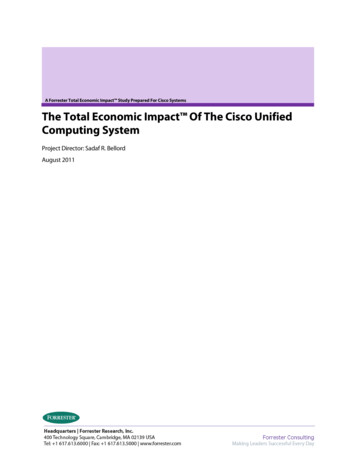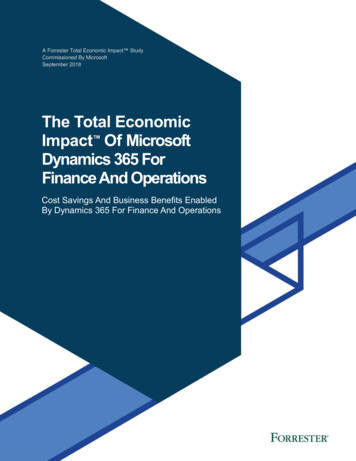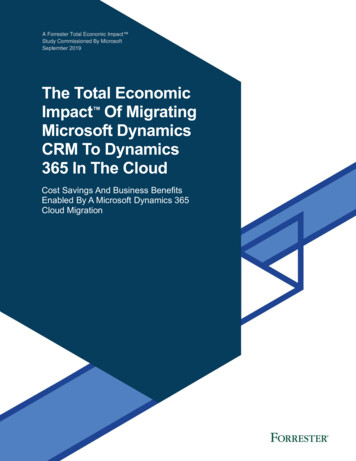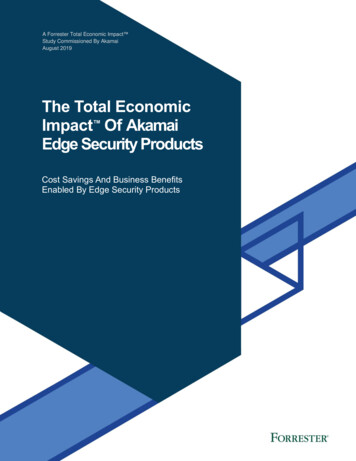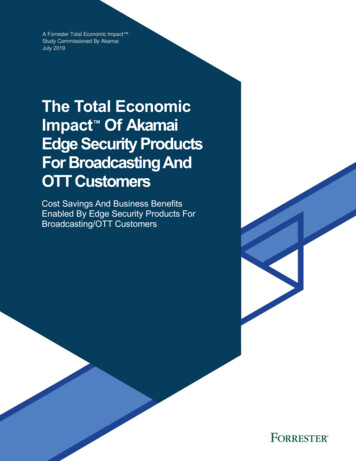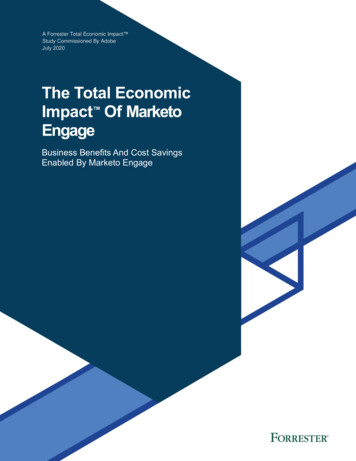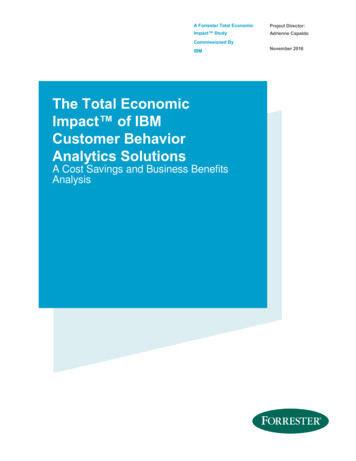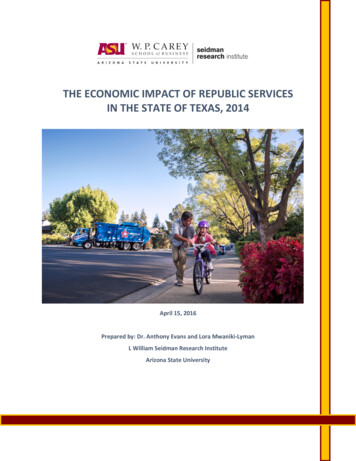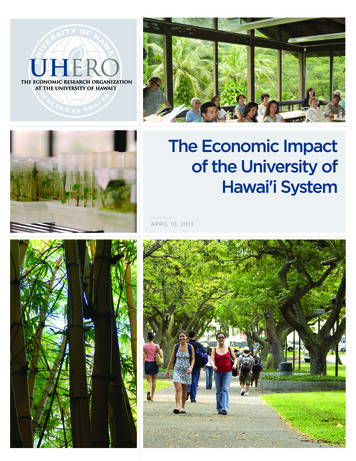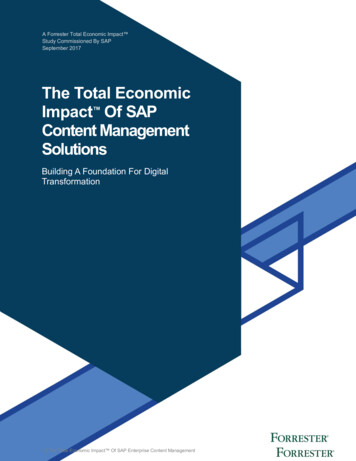
Transcription
A Forrester Total Economic Impact Study Commissioned By SAPSeptember 2017The Total EconomicImpact Of SAPContent ManagementSolutionsBuilding A Foundation For DigitalTransformation1 The Total Economic Impact Of SAP Enterprise Content Management
Table Of ContentsExecutive Summary1Key Findings1The SAP Extended ECM Customer Journey5Interviewed Organizations5Key Drivers5Key Results6Solution Requirements7Benefits Analysis9Remote Access To Archived Documents9Automation Of Product Documentation10Printing Efficiency From Document Presentment11Accounts Receivable Processing Costs Reduction12Accounts Payable Processing Costs Reduction13Early Payment Discounts Improvement14Cost Savings Of Document Storage Space15Improved Compliance Effectiveness15Decommissioning Obsolete Content Management Tools16Cost Analysis19Licenses And Maintenance19Implementation Costs20Document Scanning21Infrastructure Costs: Hardware, Storage, OS21Support Costs22Financial SummarySAP Content Management Solutions: Overview2324ABOUT FORRESTER CONSULTINGProject Director:Jeffrey NorthPrincipal ConsultantForrester Consulting provides independent and objective research-basedconsulting to help leaders succeed in their organizations. Ranging in scope from ashort strategy session to custom projects, Forrester’s Consulting services connectyou directly with research analysts who apply expert insight to your specificbusiness challenges. For more information, visit forrester.com/consulting. 2017, Forrester Research, Inc. All rights reserved. Unauthorized reproductionis strictly prohibited. Information is based on best available resources.Opinions reflect judgment at the time and are subject to change. Forrester ,Technographics , Forrester Wave, RoleView, TechRadar, and Total EconomicImpact are trademarks of Forrester Research, Inc. All other trademarks are theproperty of their respective companies. For additional information, go toforrester.com2 The Total Economic Impact Of SAP Enterprise Content Management
Executive SummaryThree-Year BenefitsAnd CostsMultiple categories of processefficiency and cost avoidancebenefits: 4,439,000Software, storageimplementation, and supportcosts: 2,639,000Three-yearROI68%Enterprise content management (ECM) is a discipline in transition.Technology and business leaders know that the volume of their businessand transactional content continues to grow. The fast pace of change inthe technology and competitive landscape provides new opportunities andrisks as businesses strive to grow revenue and serve customers. Newbusiness objectives, new market imperatives, and new technologies fromadjacent markets compel technology and business decision makers totake a fresh look at their ECM strategy.SAP Extended Enterprise Content Management (ECM) by OpenTextprovides effective management of many types of enterprise contentthroughout the content life cycle, with integrated connections to SAPtransactions and business objects. SAP Extended ECM combines secure,automated capture, storage, and organization of documents with archiving,records management, and imaging functionality. In addition, it providesteam collaboration, collaborative workflow, and search and retrievalcapabilities. When combined with SAP Document Presentment byOpenText and SAP Invoice Management by OpenText, as described inthis case study, the enterprise gains a platform for multichannel delivery ofdocuments and dynamic correspondence, as well as a comprehensivemodule for managing all aspects of accounts payable operations.SAP commissioned Forrester Consulting to conduct a Total EconomicImpact (TEI) study and examine the potential return on investment (ROI)enterprises may realize by deploying SAP Extended ECM with SAPDocument Presentment and SAP Invoice Management. The purpose ofthis study is to provide readers with a framework to evaluate the potentialfinancial impact of this product suite on their organizations.Forrester’s interviews with SAP customers with years of experience usingthese products in concert and resulting financial analysis found that acomposite organization based on these organizations would experiencebenefits, costs, and a risk-adjusted ROI shown below. This studydescribes the value created by making enterprise content accessible tofield employees; automating technical, multi-language product documents;creating cost-saving efficiencies in accounts payable and receivableoperations; streamlining printer networks; and saving space and money onstorage.Key FindingsQuantified benefits. The following risk-adjusted quantified present value(PV) benefits are representative of those experienced by the companiesinterviewed over three years:› Remote access to archived documents. A model organization canaccrue 1.29 million over three years by giving access to data andtechnical diagrams to customer-facing field staff via mobile devices.› Automation of product documentation. Forrester calculated 504,000in time saved by merging product, customer, and compliance data toauto-generate documents from formerly siloed content residing in SAPExtended ECM.› Automation of invoice management and related vendor- andcustomer-correspondence. Together, these are worth nearly 809,000,plus 336,000 in additional payment term discounts.1 The Total Economic Impact Of SAP Enterprise Content Management
Three-yearROI68%Benefits PV 4.4 millionNPV 1.8 millionPayback15.4 months“We have seen so manyadvances using SAPDocument Presentment thatthere’s no discussion aboutROI. Because things arespeeding up, and we have builtsome integrations that are veryhelpful, [we are] saving a lot oftime. So, there’s never adiscussion about the cost.Ever.”› Printer network streamlining, compliance cost reduction, storage costsavings, and decommissioning old tools. These benefits sum to acombined value of 1.5 million.Unquantified benefits.While the quantifiable ROI has turned out to be very positive, none of thecompanies, utilities, or municipalities in this study focused on that as theprimary factor prior to making their investments in SAP ECM, SAPDocument Presentment, or SAP Invoice Management. Rather, eachorganization had a critical business challenge that was solved when theseSAP products were selected after evaluating competing products.Subsequently, each organization invested further in ECM for more value invarious other areas of their organizations.Each organization gave Forrester an account of discovering value so greatthat they were reluctant to calculate a financial amount. What is the value,for example, of automatically generating a technical drawing that describesexactly the one-off assembly part the company wishes to purchase froman overseas supplier, with all supporting documents to initiate, authorize,and pay for the purchase? Lead time and errors go to zero, with follow-onvalue from the company’s customers in the form of loyalty and repurchase.Or another example: what is the value of putting a property diagram in thehands (or rather, onto a mobile device) of a utility worker so she knowsexactly where (and where not) to dig. “We can’t put a number on that,” washeard repeatedly during the interviews.Costs. The interviewed organizations experienced the following riskadjusted PV cost categories over three years; Forrester calculated theamounts for the model organization:› Software license and annual maintenance, 676,000.› Implementation, 1.1 million.› Scanning, training, hardware, and tech support, 860,000Forrester’s interviews with seven existing customers and subsequentfinancial analysis found that a model organization based on theseinterviewed organizations would see benefits of 4.4 million over threeyears versus costs of 2.6 million, adding up to a net present value (NPV)of 1.8 million and an ROI of 68%.Application specialist, manufacturer2 The Total Economic Impact Of SAP Enterprise Content Management
Three-Year Financial SummaryPayback:15 monthsTotalbenefitsPV, 4.4MTotalcosts PV, 2.6MInitialYear 1Year 2Year 3Benefits (Three-Year) 1.3M 537.2K 503.6K 387.9K 422.8K 386.1K 335.7K 327.3K 248.7KRemote access toarchived documentsAutomation ofproductdocumentationPrinting effciency Accounts receivable Accounts payable Improved payablesCost savings:from Documentprocessing costsprocessing costsdiscounts takendocument storagePresentmentreductionreductionspace3 The Total Economic Impact Of SAP Enterprise Content ioninglegacy contentmanagement tools
TEI Framework And MethodologyFrom the information provided in the interviews, Forrester has constructeda Total Economic Impact (TEI) framework for those organizationsconsidering implementing SAP Content Management solutions.The objective of the framework is to identify the cost, benefit, flexibility, andrisk factors that affect the investment decision. Forrester took a multistepapproach to evaluate the impact that SAP Enterprise Content Managementcan have on an organization:The TEI methodologyhelps companiesdemonstrate, justify,and realize thetangible value of ITinitiatives to bothsenior managementand other keybusinessstakeholders.DUE DILIGENCEInterviewed SAP stakeholders and Forrester analysts to gather datarelative to Enterprise Content Management solutions.CUSTOMER INTERVIEWSInterviewed seven organizations using Enterprise Content Managementsolutions to obtain data with respect to costs, benefits, and risks.COMPOSITE ORGANIZATIONDesigned a composite organization based on characteristics of theinterviewed organizations.FINANCIAL MODEL FRAMEWORKConstructed a financial model representative of the interviews using theTEI methodology and risk-adjusted the financial model based on issuesand concerns of the interviewed organizations.CASE STUDYEmployed four fundamental elements of TEI in modeling SAP ExtendedECM impact: benefits, costs, flexibility, and risks. Given the increasingsophistication that enterprises have regarding ROI analyses related to ITinvestments, Forrester’s TEI methodology serves to provide a completepicture of the total economic impact of purchase decisions. Please seeAppendix A for additional information on the TEI methodology.DISCLOSURESReaders should be aware of the following:This study is commissioned by SAP and delivered by Forrester Consulting. It isnot meant to be used as a competitive analysis.Forrester makes no assumptions as to the potential ROI that otherorganizations will receive. Forrester strongly advises that readers use their ownestimates within the framework provided in the report to determine theappropriateness of an investment in SAP Enterprise Content Management byOpenText.SAP reviewed and provided feedback to Forrester, but Forrester maintainseditorial control over the study and its findings and does not accept changes tothe study that contradict Forrester’s findings or obscure the meaning of thestudy.SAP provided the customer names for the interviews but did not participate inthe interviews.4 The Total Economic Impact Of SAP Enterprise Content Management
The SAP Extended ECM Customer JourneyBEFORE AND AFTER THE INVESTMENT IN SAP EXTENDED ECM, SAPDOCUMENT PRESENTMENT, AND SAP INVOICE MANAGEMENTInterviewed OrganizationsFor this study, Forrester conducted seven interviews with SAPcustomers using Enterprise Content Management solutions. Interviewedcustomers include the following:INDUSTRYREGIONINTERVIEWEESCOPEFood and agricultureMidwest, USAEnterprise content solution leadMultinational with 150,000 employees, 25million documents, and four SAPinstancesMunicipalitySouthwest, USAProject manager11,000 employees providing essentialservices to over 1 million residentsUtilitySoutheast, USAProgrammer analystElectric, gas, water, telecom utility,serving 100,000 customersUtilityMidwest, USADirector of enterprise assetmanagement900 employees providing water and gasservice to over 200,000 customersUtilityWest, USASenior business analyst5,000 employees delivering power andwater to 1 million customersManufacturerEuropeApplication specialistGlobal machine manufacturer, sales andservice, seven companies viaacquisitions, 4,000 employeesBankingGreeceProgram directorLending and equity investments inmultiple industrial sectors in 12 countriesKey DriversThe content management specialists interviewed for this study describeda range of challenges and opportunities that were the drivers leading upto decisions to invest and deploy these SAP ECM solutions.› Lack of automated processes, ability to route information to the rightparticipants, legacy system integrations, archiving capability, andtechnical support. All were frequently described as drivers behindcompanies’ ECM investments.› First significant ECM platform investment Organizations stepped up to a first-ever initiative to leverage arobust solution to automate records management with a major boost inefficiency. as part of a larger enterprise resource planning (ERP)rationalization. Replacing legacy ERP systems opened a window tobring in content management to capture records and integrate withERP to a much greater extent than had been the case in thecompanies’ histories.› Retirement of older content management tools. Most companieshad a collection of isolated or siloed content and non-managementtools, including extensive use of shared drives and older softwareapplications that were typically the domain of individual departments.5 The Total Economic Impact Of SAP Enterprise Content Management“We needed a better way ofmanaging millions of existingdocuments, plus over 10,000 newones added every day. Previously,we had been doing that kind ofwork with other platforms looselyconnected other ERP systems.But what we had on hand at thatpoint was really a collection ofmillions and millions ofdocuments, without any realrecords management, so we hadno way of knowing which of thosecould be moved or how tounmingle different kinds ofdocument types. So, we decidedto leverage the leading applicationand drive the design from thebeginning.”Director of enterprise assetmanagement, utility
› Anticipating investments in S/4HANA. Companies were alsointerested in a content management strategy that could evolve intandem with their overall technology strategies. Firms desired anapproach to ECM that fit within their ERP vision, such as their plan toshift to SAP S/4HANA.Key ResultsThe interviews revealed that key results from the SAP Extended ECM(and related products, SAP Document Presentment and SAP InvoiceManagement) investment include:› Providing users with efficient access from within the SAPbusiness process to important, relevant, enterprise content. Whilethis might sound elementary, those we interviewed reported that givingfaster, more complete access to the information that employees needto do their jobs is game-changing. Providing executives with businessinformation via dashboards and attractive web interfaces saves greatamounts of time for them and their staff.› Providing efficient input and output for important (formerlymanual) processes. The stories customers tell of changing inefficientprocesses — like invoice processing with exceptions — and the harddollar savings from integration with existing platforms are compelling.› Automating business processes. While most organizations in thisstudy described being at the early stages of business processautomation initiatives, they see this area of ECM as currently criticaland a boon to future success of the business. Example: creating aworkspace for each bank loan so that workflows, assignments ofresponsibilities, and audit trails are automatically created, enabling asmall financial firm to respond like a much larger one.› Assuring compliance. Organizations are saving time and money bykeeping their content contained, accessible, consistently cataloged,and retained. Savings occurs in time saved by compliance staff (whoseregular jobs are often in the business units), time saved by legal staff,and a reduction in the likelihood of fines and penalties.› Using one system. While some of the organizations in this studydescribed SAP Extended ECM as their first bona fide investment in acontent management system (in place of shared drives and uncountedfile folders), others related their experience retiring older ECM toolsand creating a “single source of truth” with a consistent set of rules.The result for both camps is lower cost and assured consistency ofenterprise content, with the ability to build upon one modern contentplatform.› Reducing lead time, shipping the right product the first time, ordelivering error-free service based on content integrity, completeness,and assured context. Throughout this story, Forrester heard theaccounts of the value that ECM investing groups are accruing fromavoiding errors. None are completely able to quantify the value oferror-free orders sent faster to suppliers or knowing what spare part acustomer really needs when the parts catalog offers a confusing arrayof possible items.6 The Total Economic Impact Of SAP Enterprise Content Management
What might have started with an investment in software to solve anenterprise’s decentralized printing problem can evolve into a roadmapencompassing all the most important connecting infrastructure andbusiness activities in the company.› Creating a content foundation for the future. “We are just at thebeginning,” was a phrase often heard throughout this study. Theseorganizations are just beginning to capitalize on a foundation forexpanding the benefits of ECM to more departments in the enterprise.Legal, HR, and commercial business units are further down the list ofuser groups behind the group that pioneered the first efforts due tospecific needs described below.› Content Managers expressed eagerness to integrate SAP ExtendedECM with more SAP modules and other applications and create valuedriven scenarios for exposing key enterprise content to suppliers andcustomers. “The way we communicate with our customers andsuppliers can be very unified through SAP Extended ECM, SAPDocument Presentment, and SAP Invoice Management,” noted onestudy participant. “That’s worth quite a bit.”Solution RequirementsMost of the interviewed organizations’ investments in SAP ExtendedECM were a major leap forward in terms of satisfying a range ofrequirements and making large strides toward greater content-relatedbusiness unit efficiency. The interviewed organizations searched for asolution that could:› Manage islands and silos of content amounting to millions ofdocuments.› Get value from historical documents by digitizing, archiving, andpresenting information efficiently.› Protect important information in the event of natural disasters.› Connect with financial systems and bring efficiency to billing andpaying with rules-based treatment of exceptions.› Systematize all outgoing supplier communications related to accountspayable and receivable.› Integrate with SAP systems.› Play well with other content management tools.› Integrate with product life cycle management (PLM) systems,Salesforce.com, Workday, and more.› Bring greater efficiency to a distributed network of printers.› Manage multi-language document retrieval, printing, and shipping.Setting up for future applications. Companies looked at these initialinitiatives as the gateway projects to other applications and businessoperations within more departments throughout their companies. Whatstarts with vendor invoice management is expected to expand to createnew efficiencies in HR, legal, engineering, and commercial departments.7 The Total Economic Impact Of SAP Enterprise Content Management
Composite OrganizationBased on the interviews, Forrester constructed a TEI framework, acomposite company, and an associated ROI analysis that illustrates theareas financially affected. The composite organization is representativeof the seven companies that Forrester interviewed and is used to presentthe aggregate financial analysis in the next section. The compositeorganization that For
Forrester makes no assumptions as to the potential ROI that other organizations will receive. Forrester strongly advises that readers use their own estimates within the framework provided in the report to determine the appropriateness of an investment in SAP
